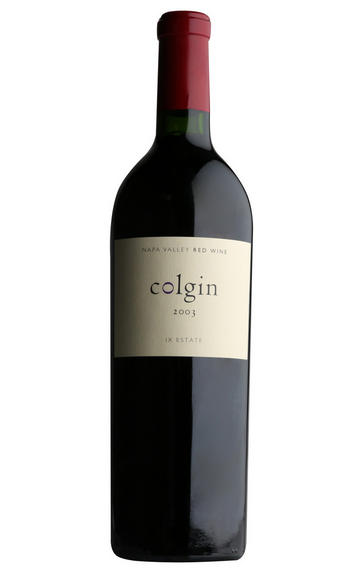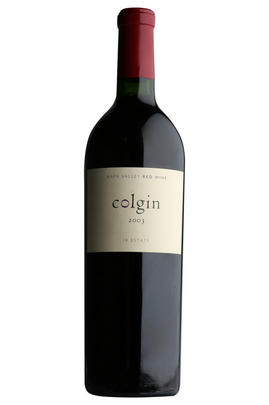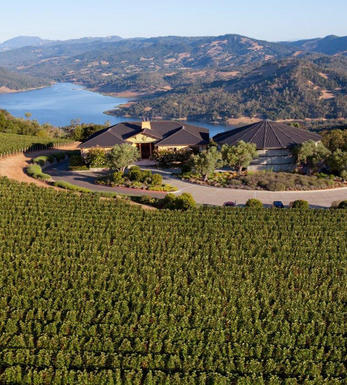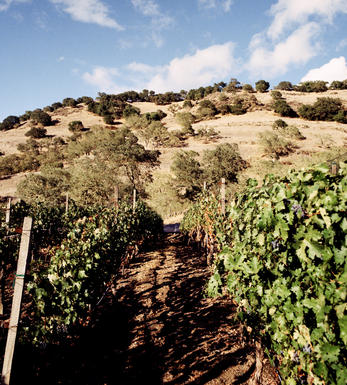
2014 Colgin, IX Estate Syrah, Napa Valley, California, USA

Critics reviews
Lastly, the 2014 Syrah IX Estate has this incredibly fragrant, flowery bouquet that makes it seem like some Viognier co-fermented with it, but it’s always 100% Syrah coming from their steep vineyards. Oodles of honeysuckle, blackberry, black cherry, graphite and some exotic white fruits seem present in this full-bodied, lush, savoury, sexy and intense wine that is irresistible in 2014, and for that reason, destined to be drunk in its first 10-15 years, although I suspect it could last longer.
Everything at Colgin is done meticulously, almost compulsively, so it’s no surprise that they have been on a qualitative surge since establishing their winery high on Pritchard Hill. On my last visit there, the 2013s had just been released, and two of those wines, the Proprietary Red IX Estate and the Tychson Hill, both scored triple digits, with the Cariad and Syrah IX Estate 2013s a mere 98 points. This is just how magnificent these wines have become. Of course, they have a talented team led by Ann Colgin.
Winemaker Allison Tauziet, who mentored under Mark Aubert, continues to develop as a superstar while working with well-known Bordeaux consultant Dr Alain Raynaud. Furthermore, the long-time viticulturalist managing these fabulous vineyards is David Abreu. The 2014s have put on weight across the board, and it’s no surprise that they are nearly as profound as the Colgin 2013s (just released in September of 2016) have turned out to be. These amazing wines from one of the world’s greatest small wineries merit serious attention.
Drink 2016 - 2031
Robert M. Parker, Jr., Wine Advocate (October 2016)
Gorgeous aromas of lean pencil, blackcurrants and raspberries. So perfumed and glorious. Full-bodied, chewy and intense with great length and intensity. Silky and muscular yet agile and energetic. It needs three to four years to resolve some of the tannins.
Ready to drink
James Suckling, JameSuckling.com (January 2017)
As to the Syrah, the 2014 Syrah IX Estate just about jumps out of the glass with incredible varietal aromatics of darker berries, bloody meat, pepper, and leather nuances. Surprisingly, it comes close to matching the 2013 in concentration and richness, yet it’s just slightly more accessible. Drink this pure, layered, incredibly satisfying Syrah over the coming 15 years.
Drink 2023 - 2038
Jeb Dunnuck, JebDunnuck.com (February 2023)
About this WINE

Colgin Cellars
Founded in 1992 in the Napa Valley, Colgin Cellars is one of the world’s most exciting fine wine producers. The story here began three decades ago. Ann Colgin, driven by a love for the land and a reverence for fine wine, was inspired to source the fruit for her first wine. This bottling, Herb Lamb, came from exceptional hillside vineyards that yield wines of harmony, grace, and precision.
About Colgin Cellars
In the years that followed, Colgin Cellars gradually added to their hillside vineyard holdings. Their reputation burgeoned and, in 2005, they were named “One of the Fifty Greatest Wine Estates in the World” by Robert Parker. Today, these singular wines have a devoted following.
Typically, Colgin Cellars’ wines are sold through direct allocation to private clients. However, we have been fortunate to secure small parcels of their four wines. These include the three Cabernet Sauvignon-based bottlings – “Tychson Hill,” “Cariad,” and “IX Estate” – in addition to the “IX Estate” Syrah.
In the vineyard
Colgin Cellars has three vineyard sites, the oldest of which is Tychson Hill. Situated just north of the town of St. Helena, this – the smallest of the Colgin Cellars vineyards (2.4 hectares) – has historic roots starting in 1860. Owned by Josephine Tychson in the late 19th-century, she was the first woman to build a winery in the Napa Valley. The vineyard was removed during Prohibition, rediscovered by Colgin in the mid-1990s, and replanted with heritage clones of Cabernet Sauvignon.
Cariad, south of Tychson Hill, is a 3.2-hectare site on volcanic, stony soils with gravelly alluvium. Here, the mineral-rich soils coupled with the cool mountain climate translate into sublime Cabernet Sauvignon-based blends.
Last, but by no means least, is IX Estate, where the Colgin Cellars winery is situated. Carved from an ancient lava flow overlooking the Napa Valley, its eight hectares, rich in well-draining clays and weathered igneous rock soils, are planted with Cabernet Sauvignon, Cabernet Franc, Merlot, Petit Verdot, and Syrah.

Napa Valley
North Coast's Napa Valley is California's most famous viticultural area (AVA), claiming some of the most expensive agricultural land in the world and producing wines of ‘cult’ status.
Its 16,000 ha of vines lie over a strip (40 miles long-5 miles wide) of diverse soils (clay, gravely, volcanic), with its northernmost end on the side of Mountain Helena and its foot in San Francisco Bay. The valley is framed by two mountains ranges Vaca (to the north) and Mayacamas (to the south), yet the main climatic influence is the cool wind and fog that is sucked in from San Pablo Bay during the afternoon, allowing grapes to ripen slowly and evenly.
The area enjoys a variety of unique microclimates, as temperatures can vary dramatically as much as 15 degrees, from the north to the south end of the valley. These differences have led to the creation of several sub-AVAs (14 in total) including:
Atlas Peak, Chiles Valley District, Diamond Mountain District, Howell Mountain, Los Carneros, Mt. Veeder, Oakville, Rutherford, St. Helena, Spring Mountain District, Stags Leap District, Yountville, Wild Horse Valley and Oak Knoll District. The Calistoga AVA is still pending approval.
Both the “Napa Valley” designation and the sub-AVA name must appear on the wine label simultaneously, with the exception of wines from the Carneros AVA, which is shared between the Napa Valley and the Sonoma County.
Cabernet Sauvignon is the undisputed king of Napa grapes, occupying over 45% of the vineyard acreage, followed by (predominantly) Chardonnay, Sauvignon Blanc, Chenin Blanc, Riesling, Zinfandel, Merlot, Cab. Franc and to a lesser extent Petite Sirah, Sangiovese, Barbera, Dolcetto.
Recommended Producers
Frog's Leap, Dominus, David Ramey, Viader, Stag's Leap Cellars, Paras Vineyards, Heitz.

Syrah/Shiraz
A noble black grape variety grown particularly in the Northern Rhône where it produces the great red wines of Hermitage, Cote Rôtie and Cornas, and in Australia where it produces wines of startling depth and intensity. Reasonably low yields are a crucial factor for quality as is picking at optimum ripeness. Its heartland, Hermitage and Côte Rôtie, consists of 270 hectares of steeply terraced vineyards producing wines that brim with pepper, spices, tar and black treacle when young. After 5-10 years they become smooth and velvety with pronounced fruit characteristics of damsons, raspberries, blackcurrants and loganberries.
It is now grown extensively in the Southern Rhône where it is blended with Grenache and Mourvèdre to produce the great red wines of Châteauneuf du Pape and Gigondas amongst others. Its spiritual home in Australia is the Barossa Valley, where there are plantings dating as far back as 1860. Australian Shiraz tends to be sweeter than its Northern Rhône counterpart and the best examples are redolent of new leather, dark chocolate, liquorice, and prunes and display a blackcurrant lusciousness.
South African producers such as Eben Sadie are now producing world- class Shiraz wines that represent astonishing value for money.


Buying options
Add to wishlist
Description
As to the Syrah, the 2014 Syrah IX Estate just about jumps out of the glass with incredible varietal aromatics of darker berries, bloody meat, pepper, and leather nuances. Surprisingly, it comes close to matching the 2013 in concentration and richness, yet it’s just slightly more accessible. Drink this pure, layered, incredibly satisfying Syrah over the coming 15 years.
Drink 2023 - 2038
Jeb Dunnuck, JebDunnuck.com (February 2023)
wine at a glance
Delivery and quality guarantee